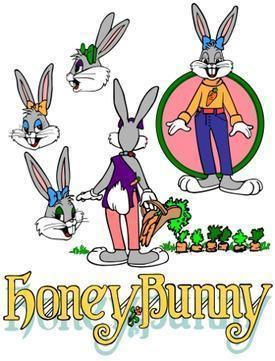 | ||
Voiced by Desirée Goyette (shows at Six Flags Astroworld), Mel Blanc (shows at Marriott's and Six Flags amusement parks) First appearance Bugs Bunny Comic Book #108 (November 1966) | ||
Honey bunny song idea
Honey Bunny is a female rabbit cartoon character and the former girlfriend of Bugs Bunny. The character, designed by Robert McKimson, was used for merchandising purposes beginning in the late 1960s.
Contents
- Honey bunny song idea
- Lasse persson honey bunny
- Comic books and merchandising
- Space Jam
- Animation and other media
- Comparison to Bugs Bunnys other girlfriends
- References
Lasse persson honey bunny
Comic books and merchandising
An early version of Honey Bunny first appeared in the Bugs Bunny's Album comic book from 1953. Instead of being portrayed as his love interest, this version of Honey Bunny is a small white rabbit (and famous African explorer) who is his cousin.
The better-known version of Honey Bunny debuted in Bugs Bunny Comic Book #108 (November 1966) and was a semi-regular fixture in the series of Looney Tunes comic books published by Gold Key throughout the 1960s and 1970s, usually co-starring with Bugs Bunny. Their relationship through the comics was somewhat variable at times; while they were often depicted as a dating couple, there were times when their relationship could be decidedly un-romantic and even adversarial if a particular story demanded it.
Honey's physical appearance also varied considerably over time. In some appearances, she had yellow or pale tan fur and wore a bow between her ears (which were worn down instead of pointing up). She was later drawn to a very "Bugs Bunny-like" model with gray fur that made her look nearly identical to Bugs himself, aside from her female clothing. Eventually, however, Honey was redesigned to a more visibly feminine model. While she still shared Bugs' basic coloration and design, her facial features (primarily her mouth and muzzle) and tail-tuft were made a bit smaller to give them a softer, more delicate appearance, her eyes were made a little larger and drawn with more prominent feminine eyelashes, and her female curves were given a bit more emphasis. This later version, which began appearing in the early 1970s, became the new "official" model and was used frequently in various Looney Tunes merchandise throughout the 1980s and early 1990s.
Space Jam
In the mid-1990s, Warner Bros. started working on Space Jam (1996). There were plans to feature Honey Bunny in the film as Bugs Bunny's female counterpart. In the concept arts, there is an athletic female rabbit wearing a head bow as well as a leotard themed around the American flag. Some artists commented that she looked too much like Bugs in drag, and eventually created Lola Bunny.
Animation and other media
Officially, Honey Bunny is considered a member of the Warner Bros. Looney Tunes characters, even though she has never officially appeared in a single animated short; her appearances were limited solely to promotional and ancillary merchandising items. However, a female rabbit with Honey Bunny's yellow character design (who is unnamed in the cartoon but credited as Honey Bunny) makes a cameo appearance in the closing scene of the Bugs Bunny's Thanksgiving Diet (1978) animated television special. She also appeared in The Bugs Bunny Crazy Castle (1989) video game and the Bugs Bunny's Birthday Ball (1990) pinball game. The most recent mention of Honey was in the book Looney Tunes: The Official Visual Guide, wherein Honey is referred to as a former travel companion of Bugs Bunny's.
Comparison to Bugs Bunny's other girlfriends
The cartoon, Hold the Lion, Please (1942), depicts Bugs married to a female rabbit (credited as Mrs. Bugs Bunny) who looks identical to him except for a bow in her hair and a yellow dress. She tells the audience that she wears the (literal) pants in the family. This character has not been seen since. Throughout the years, other female rabbits shown attraction to Bugs Bunny, including a beautiful female rabbit in a Hawaiian outfit in the cartoon Bugs Bunny Nips the Nips (1944), a shapely robotic female rabbit used as a bait for Bugs by Gossamer's creator in the cartoon Hair-Raising Hare (1946), Daisy Lou (who bears a strong resemblance to Honey Bunny's eventual character design from the 1970s-1990s) in the above-mentioned cartoon Hare Splitter (1948), Witch Hazel (who is transformed into an attractive female rabbit) in the cartoon Bewitched Bunny (1954), and Millicent (an overweight rabbit) in the cartoon Rabbit Romeo (1957). Mama Bear, in Bugs Bunny and the Three Bears (1944); Penelope Pussycat, in Carrotblanca (1995); and Elmer Fudd, in Bugs' Bonnets (1956) and Rabbit of Seville (1950), have also shown attraction to him.
Another girlfriend of Bugs Bunny's, Lula Belle Bunny, appeared in Looney Tunes & Merrie Melodies Comics and Bugs Bunny Comics between 1947 and 1955 .
In Bugs Bunny Comics #139 (1962), there appeared another girl with whom Bugs Bunny fell in love. Bertha Bunny, apart from blonde hair and feminine attire, looked much like Bugs in drag. She had a speech defect, resulting in her pronouncing parrot farm as carrot farm, which made Bugs think she owned a carrot farm.
The release of the film Space Jam (1996) introduced a new female rabbit character, Lola Bunny, who almost completely supplanted Honey as both a merchandising figure and Bugs' sweetheart. During the movie's tenure in the theaters, and for some time thereafter, Lola appeared on practically every merchandising item released by Warners or its licensees (whether or not they were tied-in to the movie).
